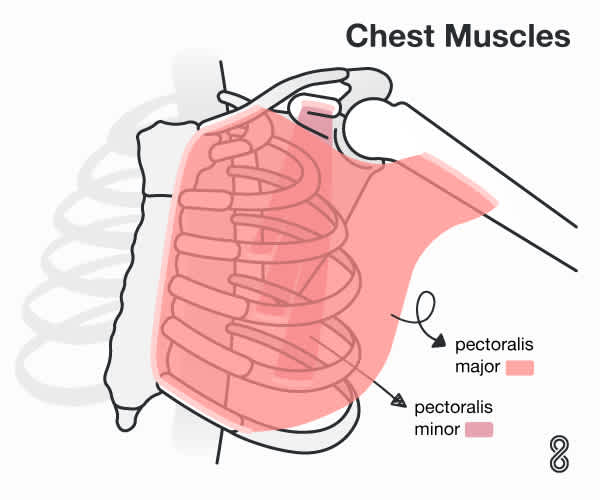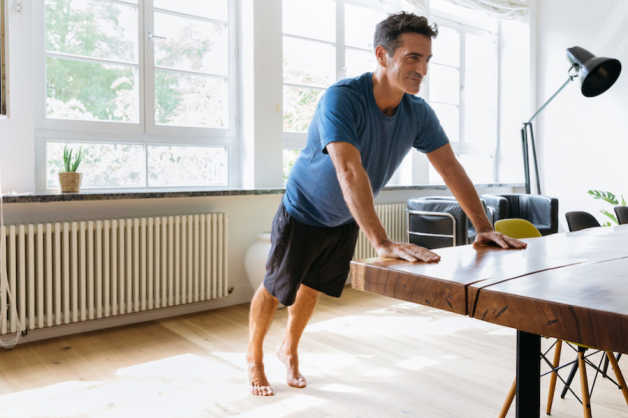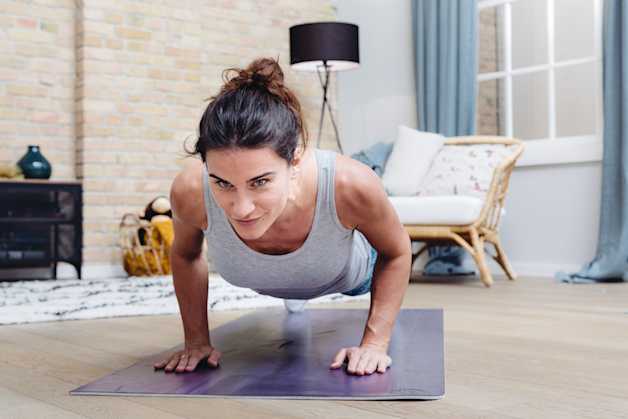We’re pretty sure a few of you out there have flipped through a fitness magazine or scrolled through some bodybuilding or workout sites, inevitably stumbling across images of buff men with protruding, sculpted chests. Though this is an extreme display of built-up pecs (pectoral muscles), that many men aspire to, having a strong, toned chest is equally essential for both men and women—and goes way beyond fitness aesthetics.
Your chest muscles are some of the most powerful muscles in your upper body and they play a key role when it comes to pushing movements—from pushing the door open to lathering up your hair in the shower. We know how important it is to include exercises that target the chest in your workouts, so you can rest assured that you’ll work those muscles by following our 8fit program. If you want more, try these at-home bodyweight chest workouts and exercises.
Why are your chest muscles important?
The chest area is made up of two primary muscles—the pectoralis major and the pectoralis minor—often referred to as ‘pecs.’ The pectoralis major is the larger of the two muscles, and extends across the upper chest, attaching to the shoulder and the breastbone and has a fan-like appearance. The pectoralis minor on the other hand is a small, thin and triangular muscle that sits just below the pectoralis major.
So what do these muscles do precisely? Well, they’re pretty significant when it comes to controlling your arm movements. From pulling and rotating your arm towards the center of your body to lifting your arms up. Think of lifting a child into your arms, swinging a tennis racket or pushing a heavy object away from you.
Additionally, as these muscles take up the majority of the chest wall, working them out will burn a considerable amount of energy. If you’re looking to shed some pounds and tone up, then this is an especially good muscle to train. It will rev up your metabolism quite nicely.
Considering the importance of this powerful muscle, we’ve crafted two tailored workouts—with and without equipment—that you can do from the convenience of your own four walls, for a toned and muscular chest.
Chest exercises at home without equipment
It’s an oldie, but a goodie—the classic push-ups and all its variations is one of the best exercises you can do to improve the strength of your chest. Varying the position of your body and the amount of time executing the exercise will hit different areas of your chest, for balanced upper body strength.
Before we get into the workout, here’s how to do different push-up variations.
1. Regular push-ups
This classic bodyweight exercise is excellent to start with as well as for keeping as a training staple in any full-body or upper-body workout. Make sure to use a wide grip, as this will work your chest muscles more than a narrow grip technique.
2. Incline push-ups
If you find a standard push-up too challenging at first, then you can start with an incline push-up. The steeper the incline, the less body weight you will need to work push. This is also a good exercise to target your lower chest.
3. Decline push-ups
What goes up, must come down. These push-ups will help you target your upper chest and deltoid muscles specifically. It will also add more of your body weight to the exercise than a standard push-up, thus making it harder.
4. Plyometric push-ups
Are you ready to explode into action? These push-ups, can be executed in a variety of fun and fantastical way, think clap push-ups. These bursts of powerful plyometric movement will have your muscles firing on all cylinders.
5. Time under tension push-ups
Believe it or not, slowing down a movement considerably and paying attention to correct form, will deliver great conditioning results. Lowering yourself very slowly down into a push-up and pushing back equally as slow into your start position will increase your muscle mass.
Home chest workout (no equipment needed)
For this workout, do three rounds of the following eight exercises. Make sure to execute each exercise in good form even when your body starts to fatigue — remember, form over speed!
- 10 regular push-ups
- 60-second star jumps
- 10 incline push-ups
- 60-second star jumps
- 10 decline push-ups
- 60-seconds star jumps
- 5 regular push-up with time under tension
- 30 mountain climbers
Chest workout at home with dumbbells
While bodyweight exercises are a handy, easy way to work your muscles with minimal fuss, adding a bit of extra weight in the form of dumbbells can take your chest workout to the next level. Read more about the difference between bodyweight training and weight training.
This next chest workout can be done at home or in the gym, and all you need is a pair of dumbbells. Adding weight will also open the door to a wide range of other effective chest workouts such as the chest press and chest flies.
If you are new at this, start with very light weights to master the technique first. When you feel confident, slowly increase the weight so the last 3-4 reps are tough to execute.
As with push-ups, varying the position of the body when doing a chest press or chest fly will target different muscles. Below are some key, weighted movements.
1. Regular chest press
Lie on a flat bench, holding the dumbbells in your hands. Stretch your arms over your shoulder, shoulder-width apart. From this starting position, inhale and descend slowly until your elbows are parallel to the floor at a 90°angle. Then push the weights back up while exhaling to return to the starting position.
2. Incline chest press
Lie on a bench with an incline with a dumbbell in each hand. Then lift the dumbbells shoulder-width apart, arms extended and rotate your wrists so that the palms of your hands are facing each other. Stay in control of the dumbbells at all times and slowly lower the weights while inhaling. Then exhale pushing the dumbbells upwards with the help of your chest.
3. Decline push-ups
What goes up, must come down. These push-ups will help you target your upper chest and deltoid muscles specifically. It will also add more of your body weight to the exercise than a standard push-up, thus making it harder.
4. Plyometric push-ups
Are you ready to explode into action? These push-ups, can be executed in a variety of fun and fantastical way, think clap push-ups. These bursts of powerful plyometric movement will have your muscles firing on all cylinders.
5. Time under tension push-ups
Believe it or not, slowing down a movement considerably and paying attention to correct form, will deliver great conditioning results. Lowering yourself very slowly down into a push-up and pushing back equally as slow into your start position will increase your muscle mass.
Home chest workout (no equipment needed)
For this workout, do three rounds of the following eight exercises. Make sure to execute each exercise in good form even when your body starts to fatigue — remember, form over speed!
- 10 regular push-ups
- 60-second star jumps
- 10 incline push-ups
- 60-second star jumps
- 10 decline push-ups
- 60-seconds star jumps
- 5 regular push-up with time under tension
- 30 mountain climbers
Chest workout at home with dumbbells
While bodyweight exercises are a handy, easy way to work your muscles with minimal fuss, adding a bit of extra weight in the form of dumbbells can take your chest workout to the next level. Read more about the difference between bodyweight training and weight training.
This next chest workout can be done at home or in the gym, and all you need is a pair of dumbbells. Adding weight will also open the door to a wide range of other effective chest workouts such as the chest press and chest flies.
If you are new at this, start with very light weights to master the technique first. When you feel confident, slowly increase the weight so the last 3-4 reps are tough to execute.
As with push-ups, varying the position of the body when doing a chest press or chest fly will target different muscles. Below are some key, weighted movements.
1. Regular chest press
Lie on a flat bench, holding the dumbbells in your hands. Stretch your arms over your shoulder, shoulder-width apart. From this starting position, inhale and descend slowly until your elbows are parallel to the floor at a 90°angle. Then push the weights back up while exhaling to return to the starting position.
2. Incline chest press
Lie on a bench with an incline with a dumbbell in each hand. Then lift the dumbbells shoulder-width apart, arms extended and rotate your wrists so that the palms of your hands are facing each other. Stay in control of the dumbbells at all times and slowly lower the weights while inhaling. Then exhale pushing the dumbbells upwards with the help of your chest.
3. Decline chest press
Secure your legs at the end of the declined bench first and then lie down with a dumbbell in each hand. Once lie down, move the dumbbells above your shoulders (shoulder width apart), palms facing each other. Lower the weights slowly until your elbows are parallel to the floor. Then bring the dumbbells back up while exhaling and contracting your chest.
4. Chest fly
Lie on a flat bench with a dumbbell in each hand, palms facing each other. Extend the arms above your chest, shoulder-width apart but keep your elbows flexible at all times (do not lock your elbows). Then lower your arms on both sides in a wide arc until you feel a stretch in your chest and then bring the dumbbells back up. Keep in mind to do the movement to the level of the shoulder joint, and not at the arms and elbows.
5. Incline chest fly
Lie on a bench with an incline with a dumbbell in each hand, palms facing each other. Extend the arms above your chest, to the width of your shoulders but keep your elbows flexible at all times (do not lock your elbows). Then lower your arms on both sides in a wide arc until you feel a stretch in your chest and then bring the dumbbells back up. Keep in mind to do the movement to the level of the shoulder joint, and not at the arms and elbows.
6. Decline chest fly
Secure your legs at the end of a bench at a decline first and then lie down with a dumbbell in each hand, palms facing each other. Extend the arms above your chest, to the width of your shoulders but keep your elbows flexible at all times (do not lock your elbows). Then lower your arms on both sides in a wide arc until you feel a stretch in your chest and then bring the dumbbells back up. Keep in mind to do the movement to the level of the shoulder joint, and not at the arms and elbows.
7. Chest dips
Chest dips are a fantastic exercise to build a strong chest and some even argue that it is the overall best chest exercise. This exercise not only adds depth to the chest but it adds width as well. Moreover, as your body isn’t supported by the bench like in a chest press, it means that other muscles are worked as you have to work harder to stabilize your body weight.
For this exercise, you won’t need dumbbells but instead another piece of equipment — either parallel bars or two flat parallel surfaces you can dip between (stable bar stools also work). Grab the bars or place hands on the flat surface and hold your body at arm’s length (arms locked), knees bent so you don’t touch the floor. With control, slowly lower your body keeping your elbows pointed out slightly until you feel a slight stretch in your chest. Be careful not to go down too low; you don’t want to hurt your shoulder joint. While exhaling, contract your chest to bring your body back to the start position.
Want to get your whole body moving? Try these total-body tabata exercises and workouts.
At-home chest workout with weights
Just like the push-up workout, this one is also three rounds, and form over speed is important! You’ll need a set of dumbbells and equipment referenced above for those chest dips.
- 10 regular push-ups
- 30 seconds chest dips
30 seconds rest - 10 chest press
- 30 seconds chest fly
30 seconds rest - 10 incline chest press
- 30 seconds chest dips
30 seconds rest - 10 regular push-ups with time under tension
60 seconds rest
Post-workout: Try this full-body stretching routine to cool down after your chest workout.
Though we’ve shown the chest area some love in this article, like anything in life, it’s all about balance, so make sure to dedicate just as much time exercising all kinds of muscle groups, to avoid muscular imbalances, injury, and postural issues down the line.
Now you’ve got these two workouts in your proverbial pocket, start incorporating it into your regular 8fit workout routine to improve your all-around strength, performance, and everyday functional movements. Want to really get moving and challenge yourself? Have a look at our HIIT Training.
Want to keep training from the comfort of home? Try some of our favorite at-home workouts.





EmoticonEmoticon